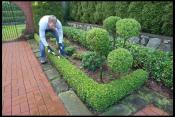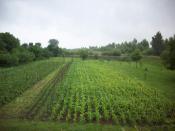Search
Login
DIY concrete walkways in the garden
The desire to equip high-quality and long-lasting garden paths for little money makes owners of cottages and suburban areas pay attention to concrete. It attracts the following: affordable cost, ease of arrangement and the possibility of using finishes, in addition - high reliability. A simple concrete laying process allows you to create concrete tracks with your own hands, their decoration can be done in the style inherent in the landscape design of the site. Of course, to create a high-quality concrete pavement, you will have to adhere to the technology of the work.
Content
- Varieties of concrete tracks and their advantages
- How to prepare the foundation for concrete garden walkways
- How to make a concrete track
- Track decoration video
- Some useful tips
Varieties of garden paths and their advantages

Concrete in modern construction is used quite often, it is obliged by its popularity:
- the possibility of long-term operation of concrete structures,
- high strength indicators, ability to withstand severe mechanical loads,
- simplicity of work with the material, the ability to refuse during the construction of the track from the services of specialists and to do without the use of special equipment,
- low cost, the opportunity at low costs to get a more comfortable movement between business facilities on the site,
- good resistance to weather conditions, in particular to high humidity and low temperatures.
It is thanks to the last point that concrete can be used in the construction of foundations and the construction of concrete walkways.
The track being built can be of any shape; to create bends, you just need to build a formwork of the appropriate shape. So that the concrete surface does not seem gray and dull, you can add special coloring pigments to the concrete mixing process, the color track will be more harmoniously written into the landscape and complement hedges or flower beds. If desired, garden paths can be decorated with tiled mosaics, fragments of natural stone, and other available materials. To do this, you need to immerse decorative elements in concrete for a couple of hours after pouring it.
How to prepare the foundation for concrete garden walkways
Note that a properly flooded track should rise slightly above the ground. The second no less important issue is the property of the material to expand at high temperature so that the track does not collapse in hot summer, it will be necessary to leave small gaps if the track is laid between two structures. In order to create a compensation space, it is possible to put a board along the foundation of the building, which could be removed in a couple of days - the necessary clearance will be obtained. If the region is not limited to capital buildings, then there is no reason for concern.

To ensure drainage, it is necessary to build a pillow-base of crushed stone and sand or of several layers of sand. If the paths provide for the presence of turns or bends, it is best to break them into pieces of the correct shape and fill each of them separately. When installing the separation boards, you must decide whether they will remain in the track or be removed from it. It will be possible to leave the boards if they coincide in height with the coating.
How to make a concrete track

Before you start work, you should prepare the usual construction tools and purchase the following materials:
- fittings, you can use twigs A3 12 mm,
- formwork boards,
- geotextiles
- cement (M 400), clean river sand, gravel or washed coarse screenings.
To prepare concrete, you will need to find a sheet of thick metal or a suitable container. If you plan to fill a large area, it is better to use a concrete mixer, its rental is not expensive, but mechanization of labor will significantly speed up and simplify the production process.
track marking and formwork installation

Start work by marking the track by installing pegs and pulling a cord between them. The winding the track, the more stakes you need to mark it.
The surface areas that we will be concreting need to be cleaned of turf and deepened a little - about 20 cm.
The lined and tamped bottom and walls of the trench will need to be lined with geotextiles - this will protect the track from erosion. Its layer will prevent the mixing of layers of soil and sand, increase the stiffness of the track, remove moisture from it. Then a layer of sand is poured, rammed and moistened, the procedure is repeated several times.

Next, you can build the formwork from boards or other auxiliary materials, for example - used plywood, outside the formwork boards should be supported with pegs. The width of the boards should match the thickness of the concrete layer. The height of the path should be 3-5 cm above the ground. The slope from the center of the path to its sides should be at least 1 cm. Dividing boards should be installed every one and a half meters. Their presence will reduce the risk of cracking due to mechanical stress or temperature changes. If the dividers are planned to be removed, then they are pre-treated with grease.
reinforcement
Concrete paths in the country will be much more reliable if reinforcement is performed before pouring concrete. As a reinforcing material, you can use a wide variety of metal objects: pieces of reinforcement, netting, fragments of metal structures and pipes,

If the means allow, you should purchase a masonry mesh with a cell of 10x10 cm. Lay reinforcement should be so that it is approximately in the center of the concrete thickness, to raise the mesh to the desired level, support bricks are laid under it.
Using a reinforcing structure will make it possible to slightly reduce the thickness of the concrete layer without violating its strength characteristics and resistance to loads. If the reinforcement is not used, then the concrete layer must reach a thickness of at least 15 cm, however, it may also not provide guaranteed strength.
how to fill a concrete path

You can fill the garden path in different ways, but, choosing the right one, you should take into account its advantages and disadvantages. The first option involves lining the bottom of the entire trench first with small, then larger stones. The masonry should be a couple of centimeters lower than the formwork. Then the solution is prepared in the proportion: 1 part of cement: 1,5 part of water: 4 parts of sand. The solution should be as thick as to keep the slope attached to the surface and at the same time - it could easily fill all the voids between the stacked stones. Remaining voids may reduce structural strength. To improve the quality of concrete, plasticizers can be added to it. They can be purchased at hardware stores and used according to the instructions on the packaging.

The second option is used more often, it consists in pouring the prepared formwork with a ready-mixed concrete solution, consisting of:
- 1 part water
- 1 part cement
- 4 parts of sand,
- 2 parts of crushed stone.
Adding crushed stone will allow creating a structural framework inside concrete, which will give the track greater strength. Screening can also be introduced into the mixture - the presence of fillers of different fractions in concrete works to strengthen the material.

When preparing concrete, the recommended proportions should be followed, excess water will lead to a significant decrease in its quality and cracking after drying, the disadvantage is the formation of voids inside the coating.
Pour the prepared solution immediately over the entire area of \u200b\u200bthe track, then equalize. So that the gravel does not protrude outward, you can pour concrete a couple of centimeters below the level of the formwork, then make a solution without adding stones and pour it until the desired level is reached.

For uniform distribution of the solution, a vibrating rail or other devices are used, but in the case of using a ready-made moving mixture, concrete will not need to be compacted.

To give smoothness to the top layer of concrete, the rule is used if it is not there, you can use a flat board. After leveling, the surface is ironed, this procedure will prevent the appearance of dust and protect the concrete mass from moisture. Ironing is carried out by applying to the surface of freshly laid concrete a two-millimeter layer of a specially prepared mixture. It should contain:
- high quality portland cement
- water
- filler, which can be used as sand,
- modifying additives.
Sometimes, for the same purpose, the surface of concrete is covered with dry cement.
After leveling, the surface is covered with a film - it will prevent the concrete from drying out quickly, which is extremely undesirable. In addition, it is advisable to water the surface for 5-7 days, especially if the weather is hot.

It is possible to remove the formwork after the concrete has completely hardened - after 2-3 days. It is recommended to start walking along the path in about a week - during this time the concrete will completely harden and gain strength.
Track decoration

If it was originally planned to decorate the surface of the track, then immediately after laying the concrete, fragments of colored glass or mosaics, pieces of tile, gravel, beautiful multi-colored pebbles should be deepened into still soft concrete.

Common decoration methods are polishing with special impregnations, which include potassium or sodium liquid glass, for example, the presence of fluoride silicate in the impregnation provides high adhesion and promotes the formation of a very strong coating. The impregnations made on the basis of wax and resins are also distinguished by excellent quality characteristics; they are able to penetrate into the pores found in concrete and protect it from moisture.

Often during the construction of garden paths, a drawing imitating a fragmentary stone is used as decoration. The surface of the tracks with the prints of beautiful leaves or any objects looks unusual. Special plastic molds for making tracks are especially popular today.
The drawing is carried out the day after pouring concrete, it will still be quite loose and drawing lines on it with, for example, a spatula or a screwdriver will not be difficult. The depth of the lines should be 0.5 mm. Over time, the lines will fill with dust and soil, this will give the surface the appearance of a fragmentary stone.

If it is planned that the track will be actively operated and increased loads will be placed on it, then resort to laying concrete tile on its surface. It is bought ready-made or made by hand.
More difficult will be the option of constructing a concrete track on an inclined surface. If the slope is too large, then pouring concrete on it is generally not recommended: rain, snow, icing will make the surface slippery and dangerous for pedestrians.

If the slope is small, then it can be corrected - remove the soil from an elevated place and pour it into the lower part. If the transition is steep, it is better to equip it with steps, and they should be long and low.
Some recommendations from experts

- Cement tracks laid on rammed earth will last much longer. A mixture of gravel and sand during the preparation of the track is poured to a height of 10 cm, be sure to tamp.
- The height of the track should not exceed 20 cm.
- To prevent cracking of the material from temperature extremes, it is recommended to make seams in increments of 1.5 -2 m.
- Concrete can be mixed with your own hands or bought ready-made - if the calculation shows that it will require more than 3 cubic meters, then the last solution will be rational.
- As a rule, to level the concrete surface, you can use a regular even board whose width will correspond to the width of the track.
- It is better if the cement hardens under the film for a week. It is recommended to press down the film with something heavy - so that it is not blown away by the wind.
- It is impossible to remove the formwork before the concrete mass has hardened.





